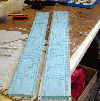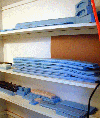|
||||
| Here we have Hugh Letterly (right) looking on while Kenny Hoag measures out a batch of resin for the next run of kits. The precise amount of resin is then injected into the mold using a syring for accuracy. |  |
|||
| Here's where the actual casting takes place. Built into the bench is one of the vacuum chamber. These are used to remove the air bubbles from the resin molds during the casting process. |  |
|||
| Here's a look at one of the molds opened up to show the
details of the male and female halves. This design allows for both the
upper and lower half of a part to be cast in one operation. The mold has
several alignment pins cast in to keep the halves lined up. Resin is fed
into the mold by means of a runner, also called a sprue.
This is where the some of the molds are stored awaiting there next use. Note the open face molds on the top right |
 |
|||
 |
||||
| The parts that come out of the molds are laid out and inspected.
The various parts sprues are collected with all the parts that make up
a kit and packed into individual bags. These parts are molded in a two
piece mold, making them similar to injection molded plastic kit parts.
The advantage of the RTV mold is that it is flexible and allows for a greater level of detail than in an injection mold. Injection molds must have a minimum draft on the parts to allow them to be ejected from the mold. The main disadvantage is that the silicone rubber mold will break down and have to be replaced after a relatively short run of parts. |
 |
|||
 |
||||
 |
||||
| Did you ever wonder how they make the molds for those resin
kits? On the right is the master for the USS
Mettawee. The hull and parts have been mounted on a base A gate
is then placed around the master and filled with silicone rubber. When
it hardens the gate is removed as is the master. The result is a mold such
as the open face style mold at the top of the photo on the right.
The parts that come out of that mold are cast on a wafer that is then sanded away to release the part. |
 |
|||
 |
||||
| Here are some sneak peaks at some of the projects in the works at Loose Cannon Models. | ||||
| This is the master in the works for the Canadian Coast Guard cutter "Sir John Franklin". | ||||
| Here are a couple more ship masters in the works, a Gilliam Class APA, followed by an Artimas class AK, both WWII era ships. |  |
|||
 |
||||
| Here are a number of 1/700 scale vehicles that will become masters for a civilian vehicle accessory set in the works. Note the Skywave 6x6 truck for reference. |  |
|||
| A bridge upgrade for the Akagi aircraft carrier is also in the works. | ||||
| For a list of current Loose Cannon Kits click the logo on the rights | ||||
| Loose Cannon
Models
Hugh Letterly 12384 E. Cedar Circle Aurora, Colorado 80012 hugh1lottie2@earthlink.net |
||||
| All kits available direct from Loose Cannon
add $4.00 S & H per order Makes checks payable to Hugh Letterly Also available at:
|
||||

